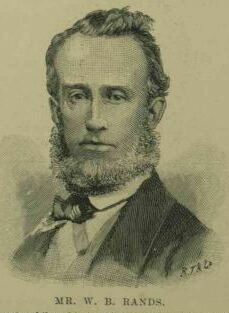William Brighty Rands facts for kids
Quick facts for kids
William Brighty Rands
|
|
|---|---|
 |
|
| Born | 24 December 1823 Chelsea, Middlesex, England |
| Died | 23 April 1882 (aged 58) East Dulwich, London, England |
| Pen name | Matthew Browne, Henry Holbeach, Tame . Talker. |
| Occupation | Writer |
| Nationality | English |
| Period | 19th century |
| Genre | Children's Literature |
William Brighty Rands (born December 24, 1823, in Chelsea, England – died April 23, 1882, in East Dulwich, London) was an important British writer. He is famous for writing many children's nursery rhymes during the Victorian era. He went to school for a few years but mostly taught himself. He also worked in the British Parliament. He used different pen names, like Matthew Browne and Henry Holbeach.
Contents
The Early Life of William Brighty Rands
William Brighty Rands grew up in a family where his father made candles. He went to school from age 8 to 13. After that, he mostly taught himself. He started reading very early and became good at languages like Latin and Greek. When he began working for an international merchant, he also learned Spanish and French. He loved learning languages his whole life, even studying Chinese when he was older.
William Rands' Career in Parliament
In 1857, William Rands started a job as a reporter in the House of Commons. This is part of the British Parliament, where laws are made. He worked for a company called Messrs. Gurney & Co. People thought he was very helpful in his job. He wrote his children's books and poems when Parliament was not meeting. In 1875, he stopped working there because he wasn't feeling well.
Writing Under Different Names
William Rands used several different names when he wrote his books and poems. These are called pseudonyms or pen names. Some of his most well-known pen names were Matthew Browne, Henry Holbeach, and T. Talker.
Other Works and Legacy
For a while, William Rands was a regular preacher at a church in Brixton. He wrote several popular hymns, which are religious songs. These hymns, along with his nursery rhymes, were printed many times throughout the 1800s. He also wrote a two-volume book about "Chaucer's England." This book explored the time period of the famous writer Geoffrey Chaucer. One of his most famous poems, "Great Wide Beautiful Wonderful World," was published in a collection called Lilliput Lectures in 1871.

